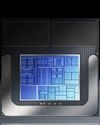EVERYTHING YOU NEED TO KNOW, FROM CAVEATS TO COMPATIBILITY TO SPECS
AMD’S NEW RYZEN PLATFORM USHERS IN THE FIRST BIG CHANGES TO PCIE SINCE 2010.

Come July, AMD gets to hoist the trophy in the race to the next-generation PCIe 4.0 interface for desktop PCs. By combining its upcoming Ryzen 3000 CPUs, Radeon RX 5700 graphics, X570 chipset, and a new spate of PCIe 4.0 SSDs, consumers will be able to build or buy the first PCIe 4.0-based PC.
PCIe 4.0 sounds exciting—it’s the first big change to the interface since 2010. But as always, the questions of who can get it (and who can’t), and who really needs it, are more nuanced than you’d think. Keep reading to get the all the details.
WHAT IS PCIE 4.0?
PCIe 4.0 is the next iteration of the PCIe interface. It’s used for connecting add-in cards and M.2 drives, as well as interconnecting various chips inside a PC. Compared to its predecessor PCIe 3.0, PCIe 4.0 essentially doubles the overall throughput. The chart below from PCI-SIG lays it all out nicely:
If that looks like a boatload of bandwidth, it is. Seizing an opportunity to troll Intel and Nvidia, AMD ran Futuremark’s unreleased PCIe feature test to show how a Ryzen 7 3800X coupled with a Radeon RX 5700 in PCIe 4.0 mode offered 69 percent more PCIe throughput performance than a Core i9-9900K and GeForce RTX 2080 Ti.
REALITY VS. HYPE
One problem with AMD’s demonstration, however, is that “69 percent” performance, while most likely real, probably doesn’t actually translate into more practical gaming performance today. That’s because few games ever saturate the 32GBps of data today’s x16 PCIe 3.0 slot can carry.
This disparity between demand and supply has been proven out many times over the years. Alienware’s laptops actually limit the slot to x8 PCIe 3.0, siphoning off the rest to support the external graphics port. The reason? It doesn’t matter (much).
STORAGE
Esta historia es de la edición July 2019 de PCWorld.
Comience su prueba gratuita de Magzter GOLD de 7 días para acceder a miles de historias premium seleccionadas y a más de 9,000 revistas y periódicos.
Ya eres suscriptor ? Conectar
Esta historia es de la edición July 2019 de PCWorld.
Comience su prueba gratuita de Magzter GOLD de 7 días para acceder a miles de historias premium seleccionadas y a más de 9,000 revistas y periódicos.
Ya eres suscriptor? Conectar

Private Internet Access: A low-price, high-value VPN for everyone
This veteran VPN shows it can still hang with the best.

Hands-on: Kensington's first Thunderbolt 5 dock is built for the future
Thunderbolt 5 is here...but you'll need more than just this well-built Kensington dock to take advantage of it.

Tested: Intel's Lunar Lake chip wants you to forget Qualcomm laptops exist
Great battery life, mediocre performance, surprisingly decent gaming: That is how Intel's Lunar Lake chip stacks up.

7 laptop habits that coax the most out of your battery
Don't send your laptop into an early grave.

WordPad is gone from Windows 11. Here's how to bring it back
With the arrival of Windows 11 version 24H2, WordPad is officially gone. Want to keep using it? You're in luck.

Hackers know your social security number. Here's how to stay safe
Thanks to a multitude of data leaks, your most sensitive information is now easily accessible to the world.

20 insanely useful Windows 11 keyboard shortcuts I use every day
After so many years, I'm still discovering new keyboard shortcuts.

WHAT THE HECK IS AN NPU, ANYWAY? HERE'S AN EXPLAINER ON AI CHIPS
ALL PCS WILL SOON HAVE NEURAL PROCESSING UNITS. HERE'S WHAT THAT MEANS FOR YOU IN SIMPLE TERMS.

WINDOWS 11'S 2024 UPDAATE: 5 BIG CHANGES I REALLY LIKE (AND MORE)
WINDOWS 11'S ANNUAL UPDATE IS ROLLING OUT OVER THE NEXT FEW WEEKS.

Hackers are using AI-generated code for malware attacks
Two separate attacks have been spotted using code that was probably written by artificial intelligence.